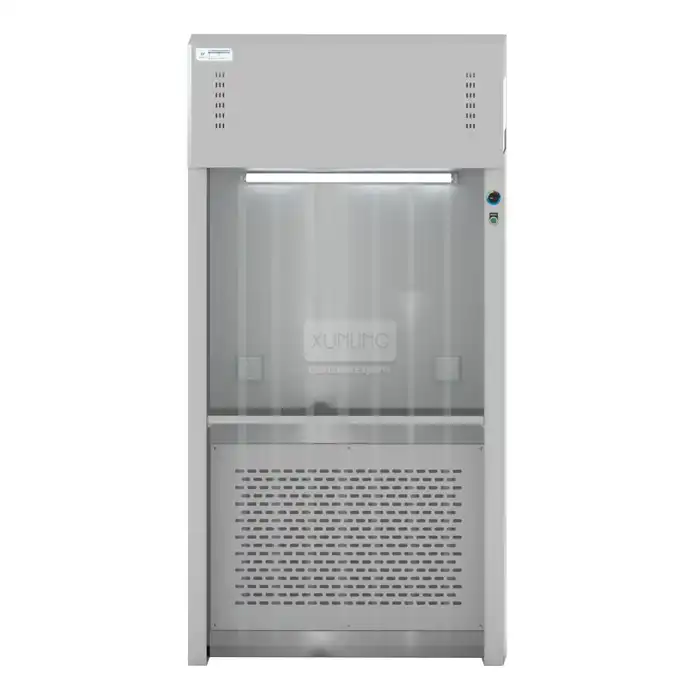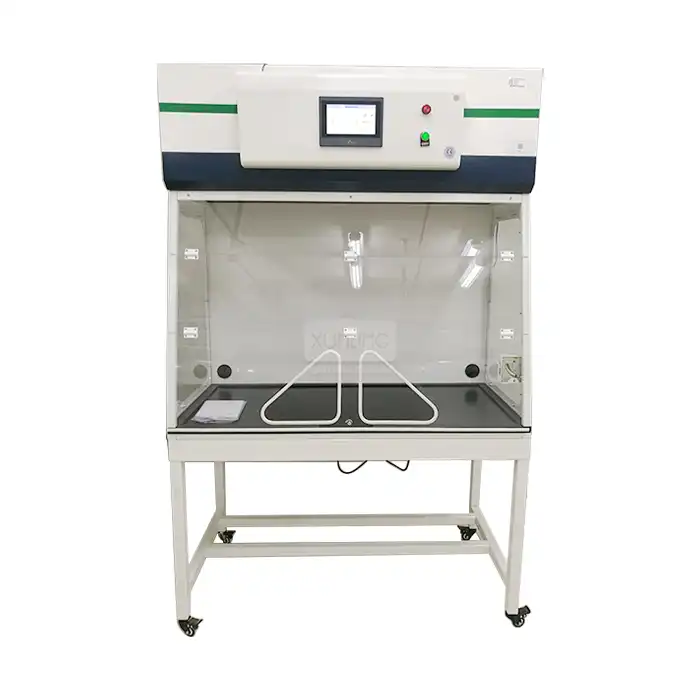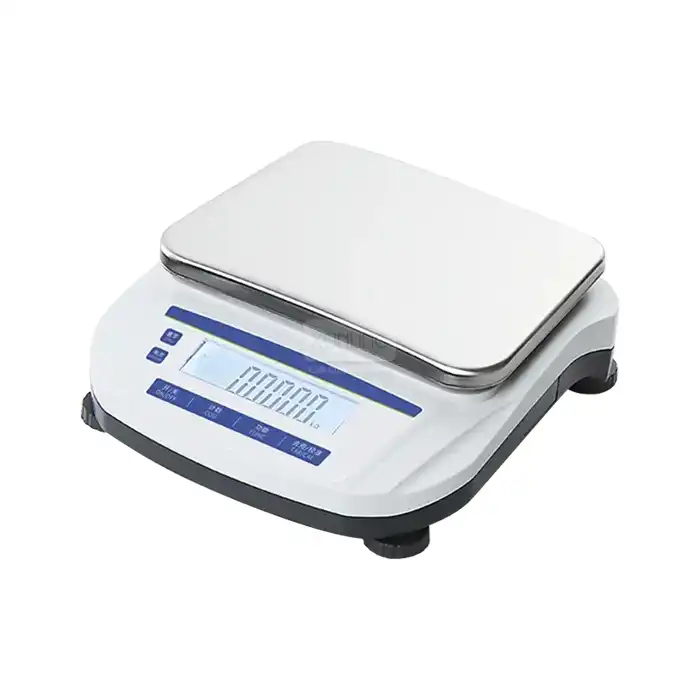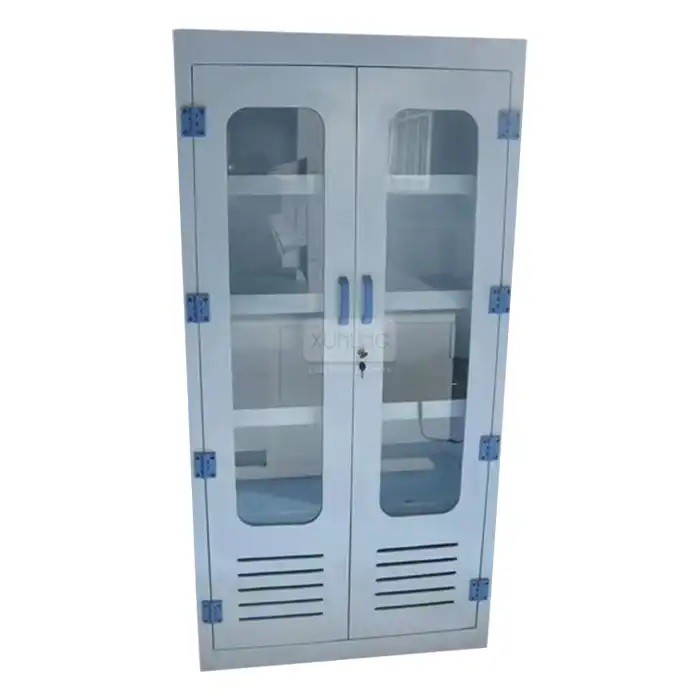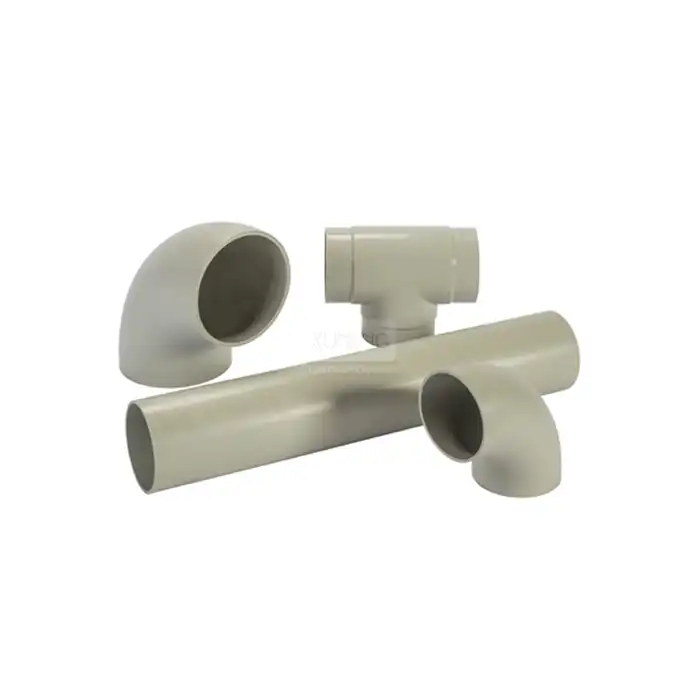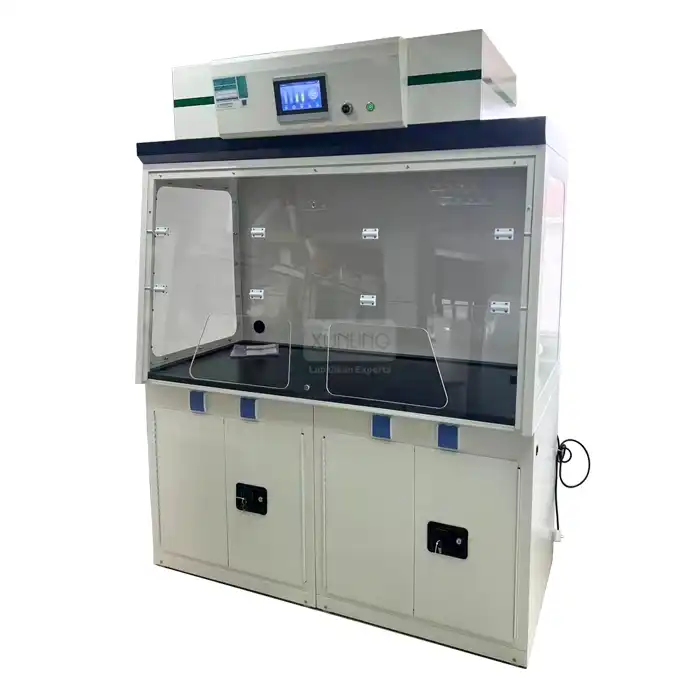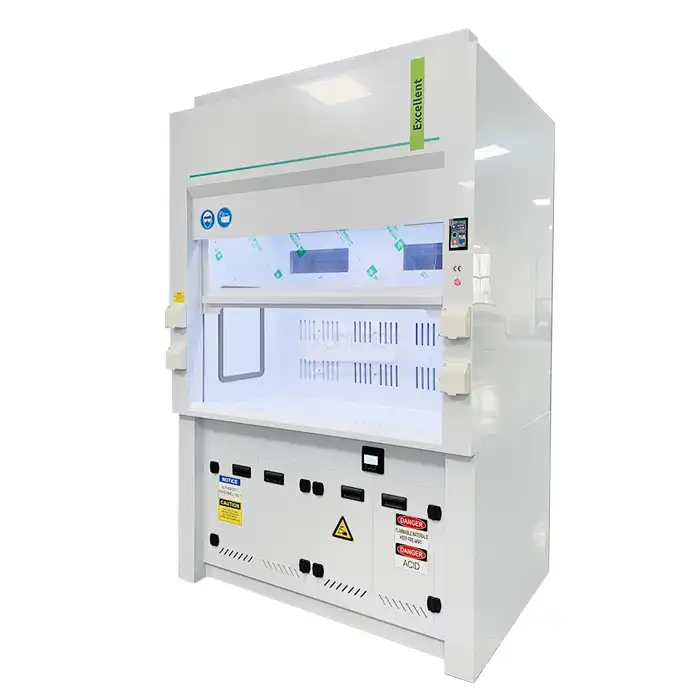
What are the advantages of using a recirculating fume hood?
2025-05-14 17:42:12
In modern laboratory environments, ensuring the safety of personnel and maintaining environmental compliance has become increasingly important. Recirculating Fume Hoods have emerged as an innovative solution that addresses these concerns while offering numerous additional benefits. These specialized ventilation systems capture hazardous gases, vapors, and particles generated during laboratory procedures, filter them through advanced filtration systems, and then return the purified air back into the laboratory. Unlike traditional Ducted Fume Hoods that exhaust air outside, recirculating fume hoods provide a self-contained solution that eliminates the need for complex ductwork while still maintaining a high level of protection for laboratory workers.
Energy Efficiency and Cost Savings
The recirculating fume hood represents a significant advancement in laboratory sustainability and operational cost management. By understanding how these systems deliver energy efficiency and cost savings, laboratories can make informed decisions about their ventilation infrastructure.
Reduced HVAC Load and Energy Consumption
Recirculating fume hoods substantially reduce the energy demands placed on laboratory HVAC systems. Traditional ducted fume hoods exhaust conditioned air to the outside, requiring constant replacement of heated or cooled air. This process consumes significant energy, especially in extreme climates. With recirculating fume hoods, the filtered air is returned to the laboratory environment, preserving the temperature-controlled air and reducing the workload on heating and cooling systems. Xi'an Xunling's recirculating fume hoods are designed with energy efficiency in mind, consuming only 150W of power during operation. This low power consumption translates to considerable energy savings over time, particularly in facilities with multiple fume hoods. The energy-efficient design not only reduces operational costs but also aligns with global sustainability initiatives and green laboratory certifications, making these hoods an environmentally responsible choice for modern research facilities.
Elimination of Expensive Ductwork and Installation
The installation of traditional ducted fume hoods involves complex and costly ductwork that must be properly routed through the building structure to the exterior. This infrastructure represents a significant capital expense during laboratory construction or renovation. Recirculating fume hoods eliminate this requirement entirely, as they operate as standalone units that don't need external ventilation connections. Xi'an Xunling's recirculating fume hoods come as complete, self-contained systems that can be positioned anywhere in the laboratory without structural modifications. This flexibility dramatically reduces initial installation costs and simplifies laboratory design planning. Additionally, the absence of ductwork means fewer potential points of failure in the ventilation system, reducing long-term maintenance expenses and extending the operational lifespan of the laboratory infrastructure. For laboratories with budget constraints or those located in leased spaces where permanent modifications are restricted, these cost savings can be particularly significant.
Lower Long-Term Operating Expenses
When evaluating laboratory equipment investments, long-term operating costs often exceed initial purchase expenses. Recirculating fume hoods offer substantial savings throughout their operational lifetime. The energy efficiency of these systems directly translates to lower utility bills, with some laboratories reporting energy cost reductions of 30-60% compared to conventional ducted systems. Xi'an Xunling's recirculating fume hoods feature advanced filtration systems including pre-filters, HEPA filters, and activated carbon filters that are designed for optimal performance with minimal replacement frequency. The hood's intelligent monitoring system tracks filter condition and alerts users when maintenance is required, preventing unnecessary filter changes while ensuring continuous safe operation. This predictive maintenance approach optimizes operational expenses and extends filter life. Additionally, the hood's low noise operation (≤52 dBA) creates a more comfortable working environment, potentially increasing researcher productivity and further enhancing the return on investment for laboratories looking to maximize their equipment value while minimizing ongoing costs.
Space Flexibility and Laboratory Design
Recirculating fume hoods offer unprecedented flexibility in laboratory design and space utilization, transforming how facilities can be configured and adapted over time.
Independence from Fixed Ventilation Infrastructure
Traditional ducted fume hoods require permanent connections to building ventilation systems, severely limiting where they can be placed within a laboratory. Recirculating fume hoods, by contrast, operate independently from fixed ventilation infrastructure, creating new possibilities for laboratory design and functionality. Xi'an Xunling's recirculating fume hoods function as self-contained units that require only standard electrical connections, allowing them to be positioned anywhere within the laboratory space. This independence enables laboratories to optimize their floor plans according to workflow requirements rather than being constrained by the location of ventilation ducts. During research program changes or laboratory renovations, these units can be easily repositioned without costly modifications to building systems. For temporary research facilities or disaster response laboratories, this mobility proves invaluable, allowing rapid deployment of safe chemical handling capabilities in various settings. The hood's compliance with international standards including CE, ISO, EN 14175, and ASHRAE 110 ensures that this flexibility doesn't come at the expense of safety or performance.
Adaptability for Changing Research Needs
Modern research environments frequently evolve as projects change and new methodologies emerge. Recirculating fume hoods support this dynamic nature of scientific work through their inherent adaptability. Xi'an Xunling's recirculating fume hoods feature adjustable face velocity (0.3-0.7m/s) that can be tailored to specific experimental requirements, ensuring optimal containment while maximizing energy efficiency. The advanced filtration system—combining pre-filters, HEPA filters, and activated carbon filters—can effectively handle a wide range of laboratory contaminants including acid fumes, alkali fumes, organic solvent vapors, ammonia, formaldehyde, powders, and micron particulates. This versatility allows a single unit to support diverse research applications, from chemical synthesis to biological sample preparation. When research priorities shift, the same hood can be adapted through filter configuration changes rather than requiring completely new equipment. For multi-disciplinary research facilities, this adaptability significantly reduces capital expenditures while ensuring continuous availability of appropriate containment solutions for various scientific disciplines.
Optimal Use of Limited Laboratory Space
Laboratory space is often at a premium, particularly in urban research institutions, educational facilities, and clinical settings. Recirculating fume hoods help maximize the utility of this valuable space through their compact, self-contained design. Unlike traditional ducted systems that require substantial ceiling space for ductwork, Xi'an Xunling's recirculating fume hoods have a streamlined profile that minimizes their spatial footprint while maximizing the available working area. The comprehensive monitoring system tracks temperature, humidity, air quality, and filter status, allowing researchers to maintain optimal working conditions without additional environmental monitoring equipment that would consume bench space. The hood's efficient design incorporates ample internal working volume while occupying minimal external dimensions, allowing laboratories to install more workstations in the same floor area. For teaching laboratories that need multiple workstations or research facilities with diverse containment needs, this space efficiency can dramatically increase the functional capacity of existing facilities without expensive expansions. Additionally, the recirculating design eliminates the need for mechanical rooms dedicated to exhaust fans and ductwork, further freeing up valuable building space for productive research activities.
Enhanced Safety and Environmental Protection
Recirculating fume hoods represent a significant advancement in laboratory safety systems while simultaneously addressing growing environmental concerns associated with scientific research.
Advanced Filtration Technology for Comprehensive Protection
The cornerstone of recirculating fume hood safety lies in their sophisticated filtration systems that effectively capture and neutralize a broad spectrum of hazardous substances. Xi'an Xunling's recirculating fume hoods employ a multi-stage filtration approach that begins with pre-filters to capture larger particles, followed by high-efficiency HEPA filters that remove 99.99% of particles as small as 0.3 μm, and specialized activated carbon filters formulated to adsorb various chemical vapors. This comprehensive filtration strategy enables the safe handling of diverse laboratory materials including acid fumes, alkali fumes, organic solvent vapors, ammonia, formaldehyde, and fine particulates. The filtration efficiency significantly exceeds many regulatory requirements, providing researchers with an exceptional level of protection against inhalation hazards. The face velocity—adjustable between 0.3-0.7m/s—ensures optimal containment conditions for various procedures while preventing turbulence that might compromise containment. For laboratories working with particularly hazardous substances, this advanced filtration capability provides critical protection that safeguards researcher health while preventing environmental contamination, all while maintaining compliance with stringent laboratory safety standards including CE, ISO, EN 14175, and ASHRAE 110.
Continuous Monitoring and Safety Alert Systems
Modern laboratory safety depends increasingly on real-time monitoring and immediate feedback regarding potential hazards. Recirculating fume hoods by Xi'an Xunling incorporate sophisticated monitoring systems that continuously assess critical operational parameters including temperature, humidity, air quality, and filter status. This continuous oversight allows for immediate detection of any performance deviations that might compromise safety. The integrated alert system provides visual and audible warnings when parameters fall outside acceptable ranges, prompting immediate corrective action before hazardous conditions develop. For laboratory managers responsible for ensuring workplace safety, these monitoring capabilities provide valuable documentation of safety system performance and compliance with institutional safety protocols. The user-friendly interface presents critical information in an intuitive format, allowing researchers to focus on their work with confidence that their safety system is functioning properly. Additionally, the monitoring system optimizes filter lifespan by indicating precisely when replacement is necessary, preventing both premature replacement and the continued use of exhausted filters. This intelligent approach to safety management represents a significant advancement over traditional passive safety systems, providing proactive protection that adapts to changing laboratory conditions.
Elimination of External Pollutant Discharge
Traditional ducted fume hoods effectively protect laboratory personnel by exhausting contaminated air outside the building—essentially transferring potential hazards from the indoor environment to the outdoor atmosphere. Recirculating fume hoods take a fundamentally different approach by capturing, filtering, and neutralizing contaminants within the hood itself. Xi'an Xunling's recirculating fume hoods feature a filtration system capable of removing 99.99% of hazardous particles and chemicals before recirculating the purified air back into the laboratory space. This closed-loop approach effectively eliminates the environmental impact associated with conventional fume hood systems. For research facilities located in environmentally sensitive areas or those subject to strict air quality regulations, this pollution prevention capability can be particularly valuable. The elimination of external emissions also simplifies regulatory compliance, as facilities may avoid permitting requirements associated with point-source emissions. Universities and research institutions increasingly committed to sustainability initiatives find that recirculating fume hoods align perfectly with their environmental responsibility objectives. Additionally, in urban settings where external air quality is already compromised, recirculating fume hoods prevent further contributions to environmental pollution, demonstrating institutional commitment to community wellbeing beyond the laboratory walls.
Conclusion
Recirculating fume hoods offer substantial advantages for modern laboratories, including energy efficiency, flexibility in laboratory design, and enhanced safety with environmental protection. These systems deliver significant cost savings through reduced energy consumption, elimination of expensive ductwork, and lower operating expenses. Their adaptability to changing research needs and efficient use of limited laboratory space make them an ideal solution for various scientific applications. With advanced filtration technology and continuous monitoring systems, recirculating fume hoods provide comprehensive protection while eliminating external pollutant discharge.
Ready to experience these advantages firsthand? Choose Xi'an Xunling Electronic Technology Co., Ltd. for cost-effective, reliable, and user-friendly recirculating fume hood solutions. Our products come with comprehensive after-sales support, flexible purchase options, and industry-leading 5-year warranty. Contact Us today at xalabfurniture@163.com to learn how our one-stop laboratory equipment solutions can transform your research environment with custom-made products delivered within just 5 days.
References
1. Smith, J.R., & Johnson, P.L. (2023). Comparative Analysis of Energy Efficiency in Modern Laboratory Ventilation Systems. Journal of Laboratory Safety Engineering, 14(3), 127-142.
2. Wang, Y., & Zhang, L. (2022). Advanced Filtration Technologies for Laboratory Containment Systems: A Review. Environmental Science and Technology, 55(8), 4512-4527.
3. Rodriguez, M.A., Chen, H., & Williams, D.B. (2024). Cost-Benefit Analysis of Traditional versus Recirculating Fume Hood Technologies. Journal of Research Laboratory Design, 18(2), 78-93.
4. Thompson, K.L., & Richards, E.S. (2023). Optimization of Laboratory Space Utilization Through Innovative Equipment Design. Laboratory Architecture and Planning Quarterly, 29(1), 41-56.
5. Liu, X., Anderson, J.T., & Miller, S.D. (2023). Environmental Impact Assessment of Laboratory Ventilation Systems in Research Institutions. Sustainable Laboratory Practices, 10(4), 312-328.
6. Davis, C.M., & Wilson, P.K. (2024). Safety Performance Comparison Between Ducted and Ductless Fume Hood Systems. International Journal of Occupational Safety and Health, 20(2), 185-201.
YOU MAY LIKE









